Starting point
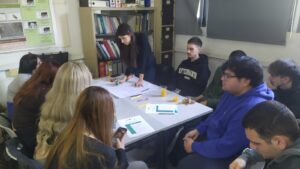 A participatory workshop was successfully conducted at the premises of the Lead Partner, University of West Attica on Thursday the 19th of December 2024, as part of the GREENMO research initiative. The event was attended by 33 participants from diverse age groups.
A participatory workshop was successfully conducted at the premises of the Lead Partner, University of West Attica on Thursday the 19th of December 2024, as part of the GREENMO research initiative. The event was attended by 33 participants from diverse age groups.
The workshop kicked off with an introductory presentation, designed to familiarize attendees with the GREENMO project and the role of mobility hubs in shaping greener, more efficient transportation systems. GREENMO project focuses on promoting low-carbon, sustainable mobility across Mediterranean regions, with a particular focus on mitigating the environmental impact of urban mobility.
Through discussions and interactive sessions, participants had the opportunity to share their thoughts and experiences, contributing valuable insights to the project’s ongoing research. The event underscored the importance of collaborative decision-making in building a more sustainable mobility future.
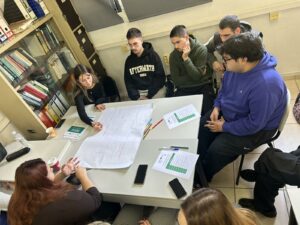
Workshop logic
To dive deeper into the topic, participants were divided into three working groups, each focusing on one of the three mobility hub types that were drafted by the consortium: urban, suburban, and rural. This interactive format allowed for more targeted discussions and encouraged participants to share their thoughts and ideas in a structured yet engaging way.
The workshop activities were carefully designed, adopting the participatory methodological approach, ensuring that all voices could be heard. The goal was to create an open and inclusive environment where participants could actively contribute to shaping the vision for future mobility hubs. More specifically, the rationale of each exercise was as follows:
- Fostering Creative Thinking: Groups engaged in discussions on ideal examples of mobility hubs, emphasizing imagination, creativity, and critical thinking.
- Needs and Expectations Analysis: Participants documented their needs, concerns, and perceptions regarding the implementation of mobility hubs, drawing on personal experiences.
- Impact Assessment: The groups explored the potential impacts of the three types of mobility hubs on citizens’ behavior and travel patterns.
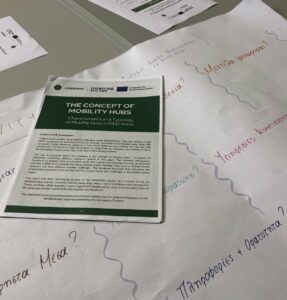 Main outcomes
Main outcomes
Urban mobility hubs
Participants viewed urban mobility hubs as a key solution for increasing public transport usage while reducing reliance on private vehicles. This shift is expected to alleviate traffic congestion, a pressing issue in Greek cities, and contribute to a more sustainable urban environment. Additionally, integrating various transport modes within a single, well-organized space could lead to shorter travel times and lower commuting costs which comprise two major concerns for urban residents.
However, affordability emerged as the most critical factor influencing the adoption of urban mobility hubs. Participants emphasized that lower costs would be a strong incentive for greater usage, making public transport a more attractive alternative to private cars. Additionally, discounted rates for both transport services and non-transport amenities within the hub were highlighted as essential measures to enhance accessibility and attract a wider range of users.
Suburban mobility hubs
When discussing suburban mobility hubs, participants highlighted seamless and efficient connections between the suburbs and the city center as a key benefit. They emphasized that well-designed mobility hubs could significantly enhance regional accessibility, improving the overall quality of urban mobility.
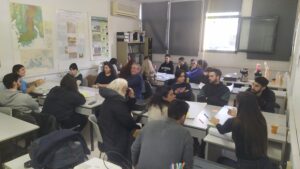 Beyond connectivity, participants also stressed the positive impact on local areas, as easier access would not only make daily commutes more convenient but also create a more enjoyable and stress-free travel experience. In this context, the most crucial factors for suburban mobility hubs revolve around convenience and comfort.
Beyond connectivity, participants also stressed the positive impact on local areas, as easier access would not only make daily commutes more convenient but also create a more enjoyable and stress-free travel experience. In this context, the most crucial factors for suburban mobility hubs revolve around convenience and comfort.
To meet users’ expectations, several key services were identified as essential. These include regular cleaning and maintenance, ensuring a pleasant and hygienic environment; on-site staff assistance, providing guidance and support; free Wi-Fi to improve the waiting experience; and modern, aesthetically pleasing infrastructure, contributing to an overall sense of comfort and security.
Rural mobility hubs
In rural areas, residents are often dependent on private vehicles to reach the nearest town, as public transport options are typically limited. The introduction of rural mobility hubs could significantly expand mobility choices, offering new transport alternatives to car reliance and gradually influencing travel habits towards more sustainable ones.
However, safety was identified as the most critical factor in the successful development of rural mobility hubs. Participants emphasized the need for:
- Security cameras to ensure a safe and monitored environment
- Fire safety measures to protect both users and infrastructure
- Well-lit facilities for increased visibility and security, especially at night
- Protected parking areas, as many users would park their vehicles at the hub while utilizing transport or other services
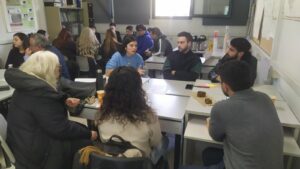
This way, trust can be built among residents regarding rural mobility hubs, encouraging them to embrace these new mobility solutions. When people know t
hey can leave their car in a well-lit, protected area and rely on safe, well-maintained facilities, they will be more open to trying the new mobility scheme. Creating a hub that feels welcoming, trustworthy, and easy to use will be essential in helping rural communities embrace more flexible and sustainable ways to get around.
Next steps
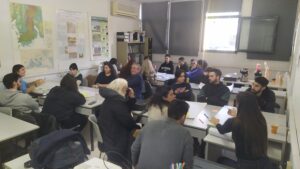 During the final session of the workshop, the next phases of the project were outlined, setting a clear roadmap for the work ahead:
During the final session of the workshop, the next phases of the project were outlined, setting a clear roadmap for the work ahead:
- Firstly, by the end of 2024, feedback from citizens across all participating countries will be collected, ensuring a diverse range of perspectives is captured.
- Then, in January and February 2025, a broader survey will be launched, using questionnaires to gain deeper insights into public perceptions and mobility needs.
- In March 2025, a gap analysis will be performed by comparing the perspectives of stakeholders and citizens, identifying key issues and opportunities to shape future mobility solutions.
Interested in our approach? Stay around!!! 😊


